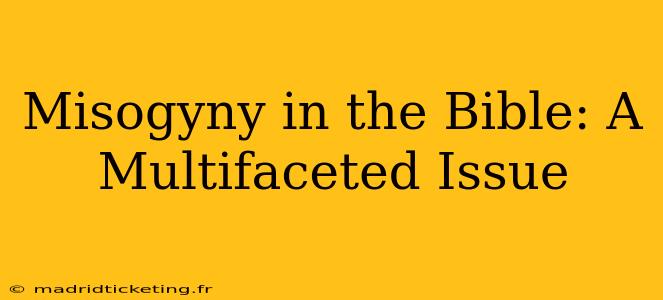The Bible, a collection of texts revered by billions, is often the subject of intense debate. One particularly contentious area is the accusation of misogyny. This isn't a simple yes or no question; examining alleged misogynistic passages requires careful consideration of historical context, literary interpretation, and evolving societal norms. This article delves into the multifaceted issue of misogyny in the Bible, exploring various perspectives and challenging simplistic interpretations.
Is the Bible Misogynistic? A Complex Question
The assertion that the Bible is misogynistic is a complex one. Some interpret certain passages as promoting the subjugation of women, pointing to verses that seem to limit women's roles in society or religious leadership. Others argue that these interpretations are anachronistic, imposing modern sensibilities on ancient texts. A nuanced understanding necessitates exploring the historical and cultural context in which these writings were produced. The Bible, spanning centuries and diverse authorship, isn't a monolithic entity with a single, consistent view on women.
What are some examples of misogyny in the Bible?
Several passages are frequently cited as examples of misogyny. These often involve depictions of women as temptresses (Eve in the Garden of Eden), submissive figures (wives obeying their husbands), or lacking in agency (Sarah's role in the story of Hagar). The punishment of women for various transgressions, sometimes disproportionate to those faced by men, also fuels this argument. However, it's crucial to understand the cultural norms of the time. These narratives reflect the patriarchal societies in which the biblical texts were written and shouldn't be interpreted without considering that context.
How do different religious groups interpret these passages?
Different religious groups interpret these passages in diverse ways. Some conservative interpretations maintain a literal reading, emphasizing traditional gender roles and hierarchies. Progressive interpretations, on the other hand, often focus on the historical context, emphasizing the patriarchal nature of the societies depicted and highlighting the positive portrayals of women found elsewhere in the text. Feminist theologians frequently offer critical readings, analyzing power dynamics and challenging traditional interpretations to promote gender equality within their faith.
Does the Bible empower women in any way?
While some passages are cited as examples of misogyny, the Bible also features powerful female figures. Deborah, a judge and prophetess, led Israel in battle. Esther, a queen, risked her life to save her people. Miriam, the sister of Moses, led the women in celebrating their liberation. These examples showcase women's strength, leadership, and devotion. It’s important to acknowledge both the positive and negative representations to arrive at a balanced understanding.
How should we interpret the Bible's portrayal of women today?
Interpreting the Bible's portrayal of women today requires a critical and nuanced approach. We must consider the historical and cultural context, acknowledging the patriarchal societies in which these texts were written and the limitations placed upon women at the time. However, this does not absolve us from confronting potentially problematic passages. A responsible interpretation involves critical engagement with the text, recognizing its complexities, and applying its principles in a way that promotes justice and equality. It's a conversation that demands ongoing dialogue and a commitment to continuously examining and interpreting scripture through a lens of social justice.
What are some alternative perspectives on the Bible and gender?
Some scholars argue that the Bible's seemingly misogynistic passages reflect the social realities of the time rather than endorsing them. Others point to the metaphorical or symbolic nature of certain narratives, arguing that they shouldn't be interpreted literally. Furthermore, the emphasis on the equality of all souls before God, regardless of gender, offers a counterpoint to interpretations focused solely on specific passages that appear to subordinate women. This highlights the importance of contextualized readings and acknowledging the multifaceted nature of biblical interpretations.
Conclusion: A Continuing Conversation
The question of misogyny in the Bible remains a complex and contested topic. There's no single, universally accepted answer. Responsible engagement requires critical analysis, consideration of historical context, and acknowledgment of the diverse interpretations offered by various religious groups and scholars. The ongoing dialogue surrounding this topic is crucial for fostering a deeper understanding of the text and promoting a more just and equitable world. The conversation continues, and a thoughtful approach is necessary to navigate its complexities.

